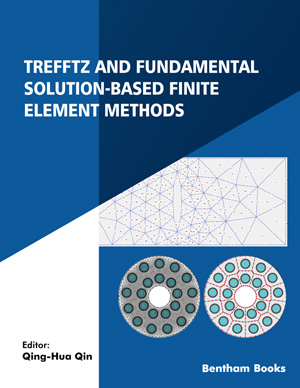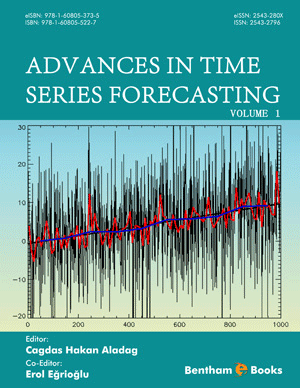Introduction to Hybrid-Trefftz Finite Element Method
Page: 1-54 (54)
Author: Qing-Hua Qin*
DOI: 10.2174/9789814998543121010003
PDF Price: $30
Abstract
This chapter presents a review on the hybrid-Trefftz (HT) finite element method (FEM) and its applications in applied mechanics and mechanical engineering. First, fundamental issues on the hybrid Trefftz FE approach are described, including elements associated with special-purposed functions, generalized variational functionals, T-complete functions, internal fields and boundary fields in an element. Then, the Trefftz FEM of contact problems, two-dimensional elastic problems, elastoplasticity, and piezoelectricity are described. Mathematical expressions for the cases mentioned are derived by means of T-complete solutions and a modified variational functional. In the case of plane elasticity and elastoplastic problems, exact solutions derived in a wellestablished way from complex variable equations are used for the intra-element fields, and an iterative form of the fundamental equations is employed in the case of elastoplasticity. The creation of force-displacement equations from the variational functional is also addressed. Finally, some conclusions are presented and some open questions in this area are discussed.
Hybrid-Trefftz Finite Elements for Non- homogeneous Parabolic Problems
Page: 55-102 (48)
Author: Ionut D. Moldovan*, Ana Coutinho and Ildi Cismasiu
DOI: 10.2174/9789814998543121010004
PDF Price: $30
Abstract
The solution of transient parabolic problems using a novel hybrid-Trefftz finite element is presented in this chapter. The governing equations are first discretised in time and reduced to a series of non-homogeneous elliptic problems in space variables only. The complementary and particular solutions of each elliptic problem are approximated independently. The complementary solution is expanded in Trefftz bases, designed to satisfy the homogeneous form of the problem. Trefftz bases include regular functions of arbitrary orders and are defined independently for each finite element. A novel dual reciprocity method is used for the approximation of the particular solution to avoid domain integration. The same regular basis is used for the expansions of the source function and particular solution, avoiding the cumbersome expressions of the latter that typify conventional dual reciprocity techniques. Moreover, the bases of the complementary and particular solutions are defined by the same expressions, with different wave numbers. The finite element formulation is obtained by enforcing weakly the domain equations and boundary conditions. The formulation is implemented in the computational platform FreeHyTE, where it takes advantage of the pre-programmed numerical procedures and graphical user interfaces. The resulting software is open- source, user-friendly and freely distributed to the scientific community.
Thermal Analysis of Composites with Trefftz Finite Element Methods
Page: 103-132 (30)
Author: Keyong Wang* and Ze She
DOI: 10.2174/9789814998543121010005
PDF Price: $30
Abstract
Hybrid Trefftz polygonal finite elements are proposed for the thermal analysis of composites reinforced by dispersed fibers. In addition to a homogenous matrix, three types of heterogeneities are considered in each polygon-shaped element: a circular inclusion, an elliptical inclusion or a coated inclusion. Based on T-complete functions satisfying the heat conduction governing equation, an interior temperature field is assumed in inclusion, matrix as well as interphase if any. Whereas an auxiliary frame temperature field is independently defined along the element outer-boundary. The piecewise T-complete functions satisfy not only the governing equations but also guarantees the temperature continuity on the interfaces by means of conformal mapping technology. By using the divergence theorem, all the integrals involved in the single hybrid functional are finally performed along the element outer-boundary only. This facilitates the finite element modelling of heterogeneous materials. Several examples are presented to demonstrate the accuracy and efficiency of the proposed method. It is also concluded that there exists a linear relationship between the maximum number of Tcomplete functions and the number of Gauss points sampled on each element side.
Hybrid-Trefftz Finite Element Method for Heat Conduction in Functionally Graded Materials
Page: 133-162 (30)
Author: Zhuo-Jia Fu*, Wen-Zhi Xu and Qiang Xi
DOI: 10.2174/9789814998543121010006
PDF Price: $30
Abstract
Accurate and efficient analysis of heat conduction behaviors in functionally graded materials (FGMs) is very important for the reliable design of equipment and structures under high temperature environments. The hybrid-Trefftz finite element method (HTFEM) for steady-state and transient heat conduction analysis in FGMs is introduced in this chapter. For transient heat conduction problems, Laplace transformation technique is adopted to deal with the time-dependent terms and then one of the popular numerical inverse Laplace transformations, Stehfest algorithm, is introduced to regain the time-dependent numerical solutions. In the HTFEM model, the Trefftz functions including the functionally graded features of the FGMs can be derived via various variable transformations, which are adopted to approximate the temperature/heat flux inside the element. The related element stiffness matrix can be obtained via a variational functional based on the developed Trefftz functions. Numerical accuracy and efficiency of the proposed HTFEM model is assessed through several benchmark examples. Compared with the standard FEM, the HTFEM is a semi-analytical and efficient computational method without the sensitivity issues of mesh distortion for heat conduction in FGMs.
Introduction to Fundamental Solution Based Finite Element Methods
Page: 163-201 (39)
Author: Qing-Hua Qin*
DOI: 10.2174/9789814998543121010007
PDF Price: $30
Abstract
Further to the discussion of hybrid Trefftz FEM in Chapter 1, this chapter presents an overview of applications of the fundamental solution based FEM for heat conduction and seepage problems. The fundamental solution based FEM discussed here is significantly different from the previous three FEM types mentioned in Chapter 1. In this method, a linear combination of the fundamental solution at different points approximates the field variable within the element. The independent frame field defined along the element boundary and the modified variational functional are employed to guarantee inter-element continuity, generate the final stiffness equation and establish linkage between the boundary frame field and the internal field in the element.
Hybrid Fundamental Solution based Finite Element Method for Axisymmetric Potential Problems
Page: 202-232 (31)
Author: Keyong Wang and Junchen Zhou*
DOI: 10.2174/9789814998543121010008
PDF Price: $30
Abstract
A hybrid fundamental solution based finite element method is proposed for analyzing axisymmetric potential problems with axisymmetric or arbitrary boundary conditions. In the proposed method, the intra-element potential field is established by using a linear combination of fundamental solutions as interior trial functions. The frame potential field is independently defined on the element boundary. To save computational time and memory, the original three-dimensional problem needs to be reduced to a two dimensional one. Both the axisymmetric geometry and the boundary conditions are expressed in the form of the Fourier series for the solution of those problems where arbitrary boundary conditions are concerned. In doing so, the two assumed fields of an element are expanded into a series of symmetric and asymmetric components. Based on the axisymmetric form of Hellinger-Reissner functional, the resultant element stiffness equation for each Fourier term involves integrals along the element boundary only. The principle of superposition is finally exploited for the final solution. Several numerical examples demonstrate high-efficiency and insensitivity to mesh distortion of the proposed method.
Rotordynamic Response of Tapered Composite Driveshafts based on Hierarchical Shaft Finite Element
Page: 233-267 (35)
Author: Rajamohan Ganesan*
DOI: 10.2174/9789814998543121010009
PDF Price: $30
Abstract
The use of conventional finite element method for the determination of flexural vibrations and rotordynamic response of rotating tapered composite shafts requires a fine mesh of Lagrangian as well as Hermitian finite elements. Such a fine mesh leads to discontinuities in the shear force and bending moments across the interfaces of the elements. In addition, the strains in individual plies are discontinuous across the element interfaces. As a consequence, the natural frequencies, critical speeds and other dynamic response variables could not be calculated with the required accuracy and efficiency. The Hierarchical finite element method combines the features and advantages of the conventional finite element method and the Rayleigh-Ritz method. It can be used in such a way that the above-mentioned limitations associated with the use of conventional finite element method can be eliminated. In the present chapter, an efficient hierarchical finite element formulation is developed for the vibration and rotordynamic analysis of tapered composite driveshafts. The accuracy and efficiency of this formulation are demonstrated. Using the developed formulation, the rotordynamic response including the natural frequencies and critical speeds of tapered composite shafts are determined. A design parametric study is also presented.
n-sided Polygonal Hybrid Finite Elements with Unified Fundamental Solution Kernels
Page: 268-311 (44)
Author: Wan-Qing Lin and Hui Wang*
DOI: 10.2174/9789814998543121010010
PDF Price: $30
Abstract
Heat conduction in anisotropic composite materials has received wide attention in material engineering. In this chapter, the n-sided polygonal hybrid finite element method with fundamental solution kernels, named as HFS-FEM, is thoroughly studied for two-dimensional heat conduction in fully anisotropic media, which can be regarded as a combination of the traditional finite element method and boundary element method. In this approach, the unknown temperature field within an n-sided polygon is represented by the linear combination of anisotropic fundamental solutions of problem to achieve the local satisfaction of the related governing equations, but not the specific boundary conditions and the continuity conditions across the element boundary. To tackle such shortcoming, a frame temperature field is independently defined over the entire boundary of polygonal element by means of the conventional one-dimensional shape function interpolation. Subsequently, by the hybrid functional with the assumed intra- and inter-element temperature fields, the stiffness equation can be obtained including the line integrals along the element boundary only, whose dimension is reduced by one compared to the domain integrals in the traditional finite elements. This means that the higher computing efficiency is expected. Moreover, any shaped polygonal elements can be constructed in a unified form with same fundamental solution kernels, including convex and non-convex polygonal elements, to provide greater flexibility in meshing effort for complex geometries. Besides, the element boundary integration strategy endows the method with higher versatility and with non-conforming mesh in the pre-processing stage of the analysis over the traditional finite elements. No modification to the HFS-FEM formulation is needed for the non-conforming mesh and the element containing hanging nodes is treated normally as the one with more nodes. Finally, the accuracy, convergence, computing efficiency, stability of non-convex element, and straightforward treatment of non-conforming discretization are discussed for the present n-sided polygonal hybrid finite elements by a few applications in the context of anisotropic heat conduction.
Hybrid Fundamental-Solution-Based FEM for Piezoelectric Materials
Page: 312-337 (26)
Author: Changyong Cao* and Qing-Hua Qin
DOI: 10.2174/9789814998543121010011
PDF Price: $30
Abstract
This chapter deals with the hybrid fundamental-solution-based finite element method (HFS-FEM) for modeling piezoelectric materials. The linear piezoelectric theory is reviewed and applied in deriving the corresponding HFS-FEM. A modified variational functional is proposed and discussed for the new model. The assumed intra-element displacement fields are presented to satisfy a priori the governing equations of the problem using a linear combination of the fundamental solutions at a number of source points located outside the element domain. To ensure the continuity of fields over interelement boundaries, conventional shape functions are employed to construct the independent element frame displacement fields defined over the element boundary.
Introduction
This reference explains hybrid-Trefftz finite element method (FEM). Readers are introduced to the basic concepts and general element formulations of the method. This is followed by topics on non-homogeneous parabolic problems, thermal analysis of composites, and heat conduction in nonlinear functionally graded materials. A brief summary of the fundamental solution based-FEM is also presented followed by a discussion on axisymmetric potential problems and the rotordynamic response of tapered composites. The book is rounded by chapters that cover the n-sided polygonal hybrid finite elements and analysis of piezoelectric materials. Key Features - Systematic presentation of 9 topics - Covers FEMs in two sections: 1) hybrid-Trefftz method and 2) fundamental FEM solutions - Bibliographic references - Includes solutions to problems in the numerical analysis of different material types - Includes solutions to some problems encountered in civil engineering (seepage, heat transfer, etc). This reference is suitable for scholars involved in advanced courses in mathematics and engineering (civil engineering/materials engineering). Professionals involved in developing analytical tools for materials and construction testing can also benefit from the methods presented in the book.












